
The Lancia Delta is a small family car produced by Italian automobile manufacturer Lancia in three generations. The first generation (1979–1994) debuted at the 1979 Frankfurt Motor Show, the second generation (1993-1999) debuted at the 1993 Geneva Motor Show, and the third generation (2008–2014) debuted at 2008 Geneva Motor Show.
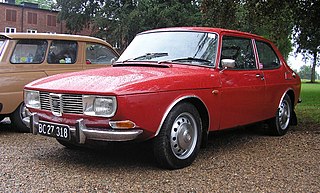
The Saab 99 is a car produced by Swedish manufacturer Saab from 1968 to 1984; their first foray into a larger class than the Saab 96. While considered a large family car in Scandinavia, it was marketed as a niche compact executive car in most other markets. It was manufactured both in Sweden and Finland and was succeeded by the Saab 900, although the 99 continued to be produced alongside its successor. The Saab 90, an updated, less complex version using many 900 parts took over from the 99 in late 1984.

The Peugeot 504 is a mid-size, front-engine, rear-wheel-drive automobile manufactured and marketed by Peugeot from 1968 to 1983 over a single generation, primarily in four-door sedan and wagon configurations – but also as twin two-door coupé and cabriolet configurations as well as pickup truck variants.
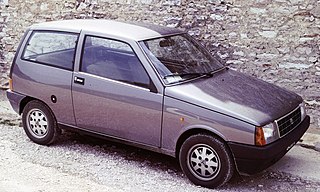
The Autobianchi Y10 is a supermini and economy car manufactured from 1985 to 1995 and marketed under the Lancia brand in most export markets. The car was manufactured at Fiat's Autobianchi plant in Desio, Milan until 1992 and after that in Arese, near Alfa Romeo's plants. In addition to a relatively high level of trim for its market segment, the Y10 featured a new rear rigid axle suspension design, subsequently shared with the facelifted Fiat Panda. In spite of its short overall length, the Y10 had a drag coefficient of just 0.31.

The Fiat Dino was a front-engine, rear-wheel-drive sports car produced by Fiat from 1966 to 1973. The Dino name refers to the Ferrari Dino V6 engine, produced by Fiat and installed in the cars to achieve the production numbers sufficient for Ferrari to homologate the engine for Formula 2 racing.
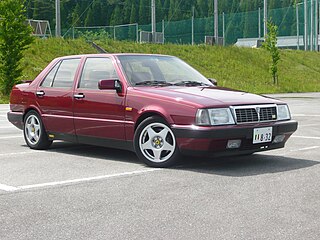
The Lancia Thema is an executive car produced by the Italian automaker Lancia between 1984 and 1994, and one of four cars to share the Type Four platform alongside the Alfa Romeo 164, Fiat Croma and Saab 9000. The Thema was first shown at the Turin Motor Show in 1984. The Thema was available as a saloon and as a station wagon designed and produced by Pininfarina.
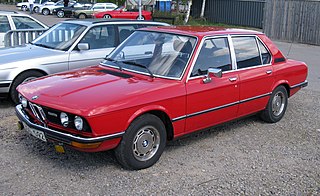
The BMW E12 is the first generation of 5 Series executive cars, which was produced from 1972 to 1981 and replaced the saloon models of the BMW New Class range.
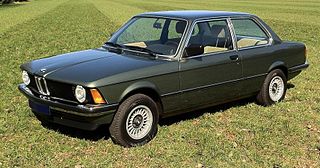
The BMW E21 is the first generation of the BMW 3 Series, a range of compact executive cars. The E21 was produced from June 1975 to December 1983 and replaced the BMW 02 Series. The series was exclusively built in a two-door coupé body style. Contrary to its predecessor, a 'Touring' body with a sloped rear hatch was no longer offered.

The Fiat Coupé, officially also known as Coupé Fiat, is a car manufactured by Fiat between 1993 and 2000. The two-door, four-seater coupé was introduced at the Bologna Motor Show in December 1993 and features an exterior design by Chris Bangle at Centro Stile Fiat and an interior designed by Pininfarina.

The Fiat 130 is a large six cylinder executive car produced by Italian car manufacturer Fiat from 1969 to 1977. It was available as a 4-door saloon and as a 2-door coupé.

The Lancia Fulvia is a car produced by Lancia between 1963 and 1976. Named after Via Fulvia, the Roman road leading from Tortona to Turin, it was introduced at the Geneva Motor Show in 1963 and manufactured in three variants: Berlina 4-door saloon, 2-door Coupé, and Sport, an alternative fastback coupé designed and built by Zagato on the Coupé floorpan.

The Lancia Flavia is an executive car produced by Italian automaker Lancia from 1961 to 1971.

The Lancia Beta, stylised as Lancia β, was an entry-level luxury car produced by Italian car manufacturer Lancia from 1972 to 1984. It was the first new model introduced by Lancia after it had been taken over by Fiat in 1969.

The Fiat 124 Sport Spider is a convertible sports car marketed by Fiat for model years 1966–1985. Designed by and manufactured at the Italian carrozzeria Pininfarina factory, the monocoque, front-engined, rear-drive Sport Spider debuted at the November 1966 Turin Auto Show with styling by Tom Tjaarda.

The Lancia Ypsilon is a supermini (B-segment) manufactured and marketed by Lancia, currently in its fourth generation and as of 2024, the marque's only model. The Ypsilon was released in 1995, as a larger and more expensive replacement to the Y10. Between 1995 and 2005, Lancia produced more than 870,000 Ypsilons in the Melfi plant in the Potenza region.

The Lancia Prisma is a small family car built by Italian car manufacturer Lancia between 1982 and 1989. It was a saloon version of the first generation Lancia Delta hatchback, and like the Delta it was designed by Giorgetto Giugiaro. Like the Delta it was also available as a 4x4 integrale version, although with a non-turbocharged engine and an air-locking rear differential.
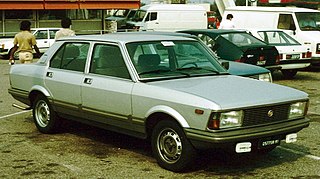
The Fiat Argenta is a large family car produced by the Italian automobile company Fiat from 1981 to 1985. It was a comprehensive update of the Fiat 132 and the last mass-produced Fiat with rear-wheel drive until the 2016 124 Spider. The change to a name came about as Fiat was changing their naming strategy, changing from three-digit numbers to more meaningful names. This model was available in sedan/saloon bodystyle only.

The Lancia Kappa or Lancia k is an executive car manufactured and marketed by Italian automaker Lancia from 1994 to 2000 in saloon, estate, and coupé body styles — sharing its platform with the Alfa Romeo 166. The Kappa has a front-engine, front-wheel-drive, five passenger, left-hand drive design.

The Lancia Gamma, stylised as Lancia γ, is an executive car manufactured and marketed by the Lancia subdivision of Fiat. Following its debut at the 1976 Geneva Motor Show as Lancia's new flagship, the Gamma was marketed as a 4-door fastback saloon known as the Berlina (1976-1984) and as a 2-door coupé (1977-1984), both designed by Pininfarina – with 15,272 and 6,790 manufactured, respectively. The Gamma superseded the Lancia Flavia.
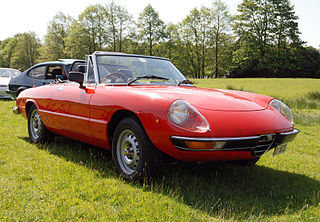
The Alfa Romeo Spider is a two-seater, front-engined, rear-drive roadster manufactured and marketed by Alfa Romeo from 1966 to 1994 in four distinct generations, or "series", each with modifications ranging from modest to extensive.
























